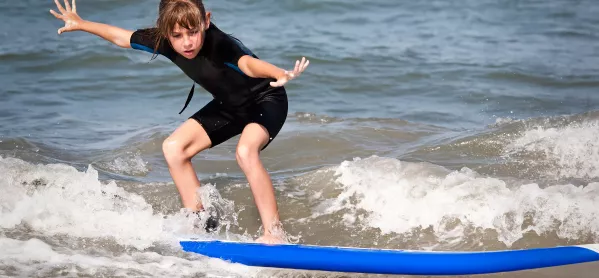- Home
- Teaching & Learning
- Secondary
- How beach school is helping vulnerable pupils to heal
How beach school is helping vulnerable pupils to heal

Surf education charity The Wave Project has announced its plans to build the world’s first Beach School for vulnerable young people in Cornwall. Joe Taylor, founder and chief executive, explains how it works and why “surf therapy” can benefit the most vulnerable students.
What is surf therapy?
Surf therapy involves taking young people who have been diagnosed with mental health disorders to the beach and teaching them to surf.
10 years ago, it was seen as being a bit of an odd idea, that just wasn’t taken very seriously. But now, there’s so much evidence that it does work that it genuinely does reduce people’s levels of anxiety and help them to build connections with other people, and develop a sense of trust, across a whole spectrum of different disorders.
Using surf lessons as a tool for education [or a type of therapy] is still quite a new idea but it’s consistent with the rationale behind projects such as Forest School and outdoor learning generally.
While the approach is really about being able to go down on the beach, with all the things that the beach offers to children, what we’re trying to do with this project is have a dedicated “surf school”, so that we’ve got all of the facilities and features we need on site.
Why is the beach itself such a key part of the approach?
The beach is such an instinctively creative space, it just appeals to all senses. The sand and that feeling of being weightless in the water can bring children to life. Surfing is also quite a mindful thing to do in the sense that you’ve got to be focused on what you’re doing. It’s quite hard to worry about your problems when you’re in the water.
Also, just the outdoors - being outside, being away from the confinement of the classroom, feeling free to physically move around - is really central to some children, especially the ones who might find it very difficult to learn in a traditional way.
And what about learning to surf? How does that benefit the young people you work with?
For children, it’s that classic therapeutic thing of presenting a challenge and then enabling the young person to overcome that challenge. Being in the waves can be quite scary, so we give young people a mentor to work with, and that helps to overcome those fears and build trust as well.
The main thing for us is the whole culture of support that we create around these children; it’s a fail-safe environment. We focus on goals that they can achieve, and get away from the whole idea of passing and failing.
For us, there’s no failing. It’s all succeeding. I know that idea isn’t massively popular in terms of educational theory right now but we found that’s what works for children who are struggling in school. They just need to feel like they’re succeeding at something, even if it’s only for an hour a day. That can get them motivated again to go back into school.
How do young people get involved?
A teacher or special educational needs coordinator will make a referral, sometimes with one child and sometimes it’s a small group, depending on what they need, and then we work with the school to find the intervention that’s right for that child.
There are two main interventions: one is Beach School, which is a curriculum of six sessions over half a term, and each session focuses on a different subject area. The other is called Surf Back to School and that’s aimed at children who are either excluded or at risk of exclusion. That’s a lot more light-touch, it’s more therapeutic in nature, but it’s still trying to reengage young people with the idea of learning. That programme also has an unlimited time frame, so sometimes we can do 12 or 13 weeks with the same child before they’re ready to go to school.
We take them for a maximum of a day a week of school and they learn at the beach, then they go back into school again. It’s very much a partnership with the school, not a replacement for school or alternative provision.
Do you ever have children who don’t want to be in the water?
All the time! Sometimes it is just working out how to get them into the sea when they’re resistant. We’re a surfing organisation, that’s what we want them to experience and be able to achieve, but we recognise that it takes time for some kids to have the confidence to do it.
We’re very much about going at their pace - and if that pace is to take three or four weeks just to be able to reach the point where they get to the water’s edge, well, that’s how long it takes them. It’s all about for us pitching it to the level the child is at and trying to help them succeed in the way that they can.
You need a Tes subscription to read this article
Subscribe now to read this article and get other subscriber-only content:
- Unlimited access to all Tes magazine content
- Exclusive subscriber-only stories
- Award-winning email newsletters
Already a subscriber? Log in
You need a subscription to read this article
Subscribe now to read this article and get other subscriber-only content, including:
- Unlimited access to all Tes magazine content
- Exclusive subscriber-only stories
- Award-winning email newsletters
topics in this article



